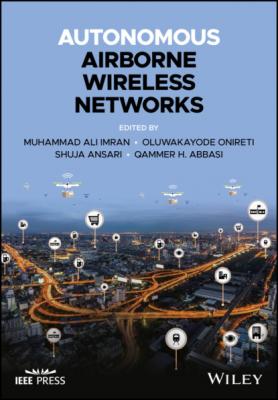Autonomous Airborne Wireless Networks. Группа авторов
Чтение книги онлайн.
Читать онлайн книгу Autonomous Airborne Wireless Networks - Группа авторов страница 18
 and Pollin, S. (2016). Joint sum‐rate and power gain analysis of an aerial base station. 2016 IEEE Globecom Workshops (GC Wkshps), pp. 1–6.
and Pollin, S. (2016). Joint sum‐rate and power gain analysis of an aerial base station. 2016 IEEE Globecom Workshops (GC Wkshps), pp. 1–6.27 27 Hayajneh, A.M., Zaidi, S.A.R., McLernon, D.C., and Ghogho, M. (2016). Optimal dimensioning and performance analysis of drone‐based wireless communications. 2016 IEEE Globecom Workshops (GC Wkshps), pp. 1–6.
28 28 Jia, S. and Zhang, L. (2017). Modelling unmanned aerial vehicles base station in ground‐to‐air cooperative networks. IET Communications 11 (8): 1187–1194.
29 29 Mozaffari, M., Saad, W., Bennis, M., and Debbah, M. (2016). Efficient deployment of multiple unmanned aerial vehicles for optimal wireless coverage. IEEE Communications Letters 20 (8): 1647–1650.
30 30 Mozaffari, M., Saad, W., Bennis, M., and Debbah, M. (2015). Drone small cells in the clouds: design, deployment and performance analysis. In 2015 IEEE Global Communications Conference (GLOBECOM), pp. 1–6.
31 31 Mozaffari, M., Saad, W., Bennis, M., and Debbah, M. (2017). Mobile unmanned aerial vehicles (UAVs) for energy‐efficient internet of things communications. IEEE Transactions on Wireless Communications 16 (11): 7574–7589.
32 32 Azari, M.M., Rosas, F., Chen, K., and Pollin, S. (2018). Ultra reliable UAV communication using altitude and cooperation diversity. IEEE Transactions on Communications 66 (1): 330–344.
33 33 Alzenad, M., El‐Keyi, A., Lagum, F., and Yanikomeroglu, H. (2017). 3‐D placement of an unmanned aerial vehicle base station (UAV‐BS) for energy‐efficient maximal coverage. IEEE Wireless Communications Letters 6 (4): 434–437.
34 34 Alzenad, M., El‐Keyi, A., and Yanikomeroglu, H. (2018). 3‐D placement of an unmanned aerial vehicle base station for maximum coverage of users with different QoS requirements. IEEE Wireless Communications Letters 7 (1): 38–41.
35 35 Khuwaja, A.A., Zheng, G., Chen, Y., and Feng, W. (2019). Optimum deployment of multiple UAVs for coverage area maximization in the presence of co‐channel interference. IEEE Access 7: 85203–85212.
36 36 International Telecommunication Union (ITU) (2003). Propagation Data and Prediction Methods for the Design of Terrestrial Broadband Millimetric Radio Access Systems. Technical report. International Telecommunication Union (ITU).
37 37 3GPP (2018). Study on Channel Model for Frequencies from 0.5 to 100 GHz. Technical report. 3rd Generation Partnership Project (3GPP).
38 38 Wentz, M. and Stojanovic, M. (2015). A MIMO radio channel model for low‐altitude air‐to‐ground communication systems. 2015 IEEE 82nd Vehicular Technology Conference (VTC2015‐Fall), pp. 1–6.
39 39 Gulfam, S.M., Nawaz, S.J., Ahmed, A., and Patwary, M.N. (2016). Analysis on multipath shape factors of air‐to‐ground radio communication channels. 2016 Wireless Telecommunications Symposium (WTS), pp. 1–5.
40 40 Zeng, L., Cheng, X., Wang, C., and Yin, X. (2017). Second order statistics of non‐isotropic UAV ricean fading channels. 2017 IEEE 86th Vehicular Technology Conference (VTC‐Fall), pp. 1–5.
41 41 Blandino, S., Kaltenberger, F., and Feilen, M. (2015). Wireless channel simulator testbed for airborne receivers. 2015 IEEE Globecom Workshops (GC Wkshps), pp. 1–6.
42 42 Ksendzov, A. (2016). A geometrical 3D multi‐cluster mobile‐to‐mobile MIMO channel model with rician correlated fading. 2016 8th International Congress on Ultra Modern Telecommunications and Control Systems and Workshops (ICUMT), pp. 191–195.
43 43 Gao, X., Chen, Z., and Hu, Y. (2013). Analysis of unmanned aerial vehicle MIMO channel capacity based on aircraft attitude. WSEAS Transactions on Information Science and Applications 10 (2): 58–67.
44 44 Yang, J., Liu, P., and Mao, H. (2011). Model and simulation of narrowband ground‐to‐air fading channel based on Markov process. 2011 International Conference on Network Computing and Information Security, Volume 1, pp. 142–146. https://doi.org/10.1109/NCIS.2011.37.
45 45 Simunek, M., Fontán, F.P., and Pechac, P. (2013). The UAV low elevation propagation channel in urban areas: statistical analysis and time‐series generator. IEEE Transactions on Antennas and Propagation 61 (7): 3850–3858.
46 46 Cid, E.L., Alejos, A.V., and Sanchez, M.G. (2016). Signaling through scattered vegetation: empirical loss modeling for low elevation angle satellite paths obstructed by isolated thin trees. IEEE Vehicular Technology Magazine 11 (3): 22–28.
47 47 Matolak, D.W. and Sun, R. (2016). Air‐ground channels for UAS: summary of measurements and models for L‐ and C‐bands. 2016 Integrated Communications Navigation and Surveillance (ICNS), p. 8B2‐1–8B2‐11.
48 48 Sun, R., Matolak, D.W., and Rayess, W. (2017). Air‐ground channel characterization for unmanned aircraft systems‐part IV: airframe shadowing. IEEE Transactions on Vehicular Technology 66 (9): 7643–7652.
49 49 Kosmerl, J. and Vilhar, A. (2014). Base stations placement optimization in wireless networks for emergency communications. 2014 IEEE International Conference on Communications Workshops (ICC), pp. 200–205.
50 50 Valiulahi, I. and Masouros, C. (2020). Multi‐UAV deployment for throughput maximization in the presence of co‐channel interference. IEEE Internet of Things Journal 8 (5: 3605–3618.
51 51 Zhao, N., Pang, X., Li, Z. et al. (2019). Joint trajectory and precoding optimization for UAV‐assisted NOMA networks. IEEE Transactions on Communications 67 (5): 3723–3735.
52 52 Zeng, Y., Zhang, R., and Lim, T.J. (2016). Throughput maximization for UAV‐enabled mobile relaying systems. IEEE Transactions on Communications 64 (12): 4983–4996.
53 53 Zeng, Y. and Zhang, R. (2017). Energy‐efficient UAV communication with trajectory optimization. IEEE Transactions on Wireless Communications 16 (6): 3747–3760.
54 54 Yang, Z., Pan, C., Wang, K., and Shikh‐Bahaei, M. (2019). Energy efficient resource allocation in UAV‐enabled mobile edge computing networks. IEEE Transactions on Wireless Communications 18 (9): 4576–4589.
55 55 Mumtaz, S., Huq, K.M.S., Radwan, A. et al. (2014). Energy efficient interference‐aware resource allocation in LTE‐D2D communication. 2014 IEEE International Conference on Communications (ICC), pp. 282–287.
56 56 Cui, F., Cai, Y., Qin, Z. et al. (2019). Multiple access for mobile‐UAV enabled networks: joint trajectory design and resource allocation. IEEE Transactions on Communications 67 (7): 4980–4994.
Конец ознакомительного фрагмента.
Текст предоставлен ООО «ЛитРес».
Прочитайте эту книгу целиком, купив полную легальную версию на ЛитРес.
Безопасно оплатить книгу можно банковской картой Visa, MasterCard, Maestro, со счета мобильного телефона, с платежного терминала, в салоне МТС или Связной, через PayPal, WebMoney, Яндекс.Деньги, QIWI Кошелек, бонусными картами